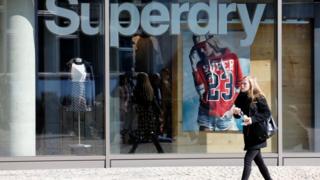What went wrong at Superdry?
 Image copyright
Image copyright
Reuters
Don’t be fooled by the Japanese characters emblazoned on its hoodies – Superdry was always a thoroughly British success story.
From a small stall in Cheltenham market, it went on to become a truly global phenomenon and a commercial success.
But 16 years after its founding, the firm started by James Holder and Julian Dunkerton is on the decline.
Its shares have lost more than 70% over the past year. In December it issued a profit warning, and last week the company announced it would cut up to 200 jobs.
Now the blame game is playing out in public.
‘Misguided strategy’
The fallout began when Mr Dunkerton stepped down from the firm’s board, in March of 2018. At the time, he departed quietly enough, citing “other demands on his time”.
But as Superdry’s fortunes began to worsen, the multi-millionaire found his voice.
He criticised the retailer’s “misguided strategy” – including a reduction in stock both in stores and online – which he claimed he had always predicted would fail miserably.
Instead, he wanted Superdry to focus more on the jackets and hoodies that made it famous, and offer a far wider range of variations on the web.
Mr Dunkerton also dismissed Superdry’s caution late last year that it was losing business due a prolonged spell of good weather in many of its key markets, causing customers to delay purchases of warmer clothing. Rival brands, he argued, had fared better, while facing similar economic conditions.
Yet as Julie Palmer, a partner at consultancy firm Begbies Traynor points out, falling profits in retail “has not been a problem exclusively experienced by Superdry”.
Big chains, she argues, “are no longer in a position to bend the will of the customer to their own styles”.
Julian Dunkerton co-founded Superdry in 2003
Winter of discontent
Superdry’s styles have been at the heart of Mr Dunkerton’s battle with the board.
The firm says he oversaw the Autumn/Winter 2018 range, which subsequently flopped.
But Mr Dunkerton claims he was cut out of the design process, and never signed off on the collection.
Regardless of who was responsible for that particular decision, Superdry’s brand was on the wane, according to fashion retail analyst Kate Hardcastle.
Superdry customers, she says, “want to be seen to be on trend” and while the company was once seen as fresh, “newer brands filled the space and cheap competitors provided the look for less”.
Its rise, she adds, “was hugely motivated by influencers, who have moved on to other products”.
To make matters worse, Ms Hardcastle says, Superdry’s bold branding is an “easy target” for counterfeiters, in a similar way that the Burberry check was vulnerable in the 1990s.
Image copyright
Reuters
Both Mr Dunkerton and Superdry disagree – they see plenty of scope for the brand to regain its cool.
But Ms Hardcastle says the company expanded too quickly, and in an attempt to maximise the brand’s potential, it may have “diluted its appeal”.
“When something is a must-have, you have to be careful not to flood the market,” she tells the BBC.
“Soon it becomes commonplace and everyone wants the new best thing.”
Mr Dunkerton remains Superdry’s biggest shareholder with an 18.5% stake.
His aim now is to convince fellow shareholders to believe in his ability to turn the company around, and to bring him back into the boardroom.
Mr Dunkerton’s return may not be the “silver bullet” the company needs, says Julie Palmer, but she predicts that while Superdry bosses have labelled his bid “extremely damaging”, shareholders “may yet flex their muscles”.
“A change back to what was successful before could be tempting, especially in a climate where we see high profile administrations on an almost weekly basis,” she says.


